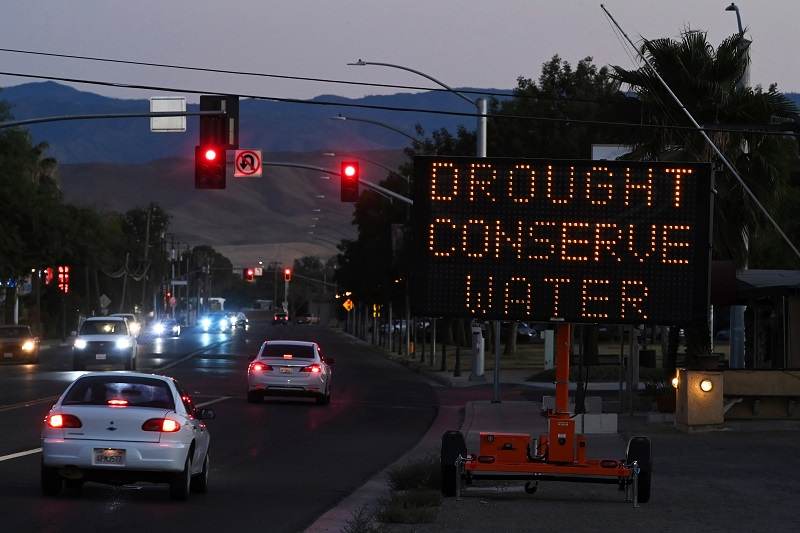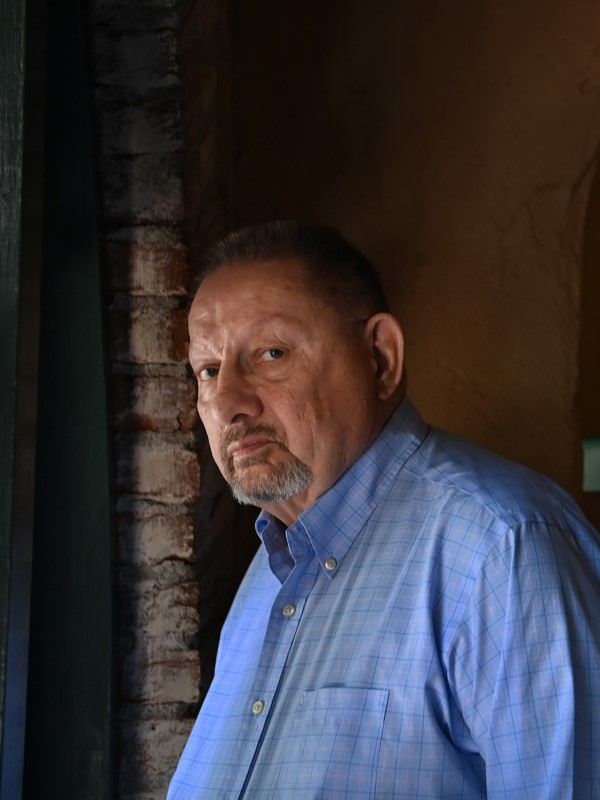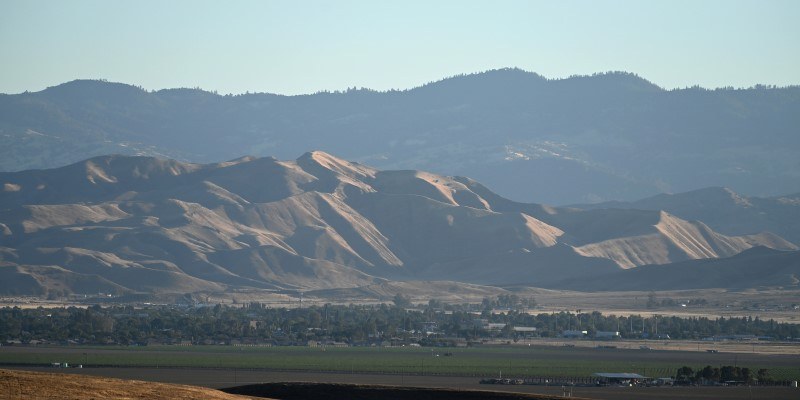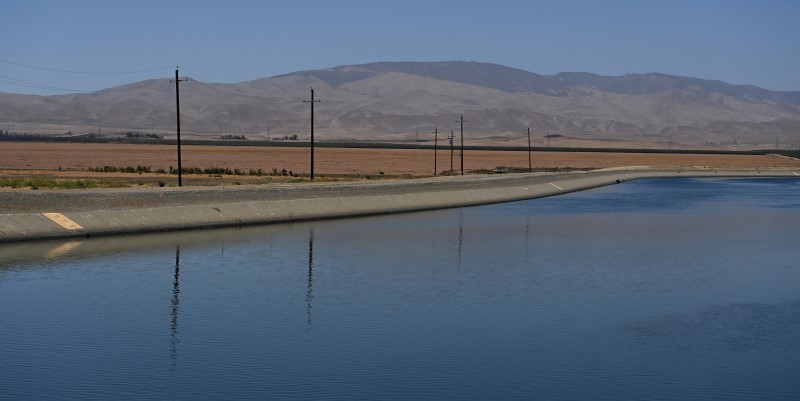A California city’s water supply is expected to run out in two months

A sign reminds Coalinga residents to conserve water. MUST
12:02 JST, October 11, 2022
COALINGA, Calif. – The residents of this sun-scorched city feel California’s endless drought when the dust lifts off the brown hills and flings grit into their living rooms. They see it when they drive past almond trees being ripped from the ground for lack of water and the new blinking sign at the corner of Elm and Cherry warning: “No watering front yard lawns.”
The fire chief noticed it when he tested hydrants in August – a rare occurrence as Coalinga desperately seeks to conserve water – and the first one shot out a foot-long block of compacted dirt. The second one ejected like a can of Axe body spray.
The schools superintendent could only think drought on the first day of school when a 4-year-old fell onto unwatered turf, breaking an arm; or when the chain saws dropped three coastal redwoods outside Henry F. Bishop Elementary that had withered and died. Superintendent Lori Villanueva even lost a portion of her own right lung last year from a drought-aggravated illness, valley fever, that’s caused by breathing soil fungus whipped up off the dry ground.
But what lies ahead might be far worse for the 17,000 residents living amid the oil derricks and cattle farms on the western edge of the state’s Central Valley. Coalinga has only one source of water – a shrinking allotment from an aqueduct managed by the federal government – and officials are projecting the city will use up that amount before the end of the year.
That looming threat has left city officials racing between meetings in Sacramento and phone calls to the U.S. Bureau of Reclamation seeking to increase their water supply. Some residents have begun stockpiling five-gallon water jugs in their homes, while many expect major spikes in their water bills. If Coalinga can’t find relief, it would be forced to buy additional water on the open market at exorbitant prices that could swamp the city’s budget.

Coalinga Mayor Ron Ramsey voted against banning the watering of front yards and ramping up penalties on overuse of water.
That was the grim scenario facing Mayor Ron Ramsey when he rapped his knuckles on the table and cursed at a City Council meeting in early August. Everyone but Ramsey had just voted to ban watering front yards and to ramp up penalties on overuse – measures they conceded would not save nearly what was needed. But it was more than Ramsey could stomach.
“It’s too much. Too fast,” Ramsey told the room. On top of that, he said, it wasn’t fair.
“Go to the state capitol and they got green grass, don’t they?” he said. “They can do it, but why can’t we?”
Coalinga, named for its history as a coal mining town, is a small Republican outpost in liberal California. The city had already defied state leadership in 2020, passing a resolution that declared all businesses essential to avoid mandatory pandemic closures. When it was time for the state to distribute covid-19 relief funds to municipalities, Coalinga didn’t get any.
The water shortage felt to some like another kind of retaliation.
“How do you not give farmers water when they feed everybody unless you’re trying to put them out of business?” asked Scott Netherton, owner of Coalinga’s lone movie theater and executive director of its chamber of commerce.
“It feels like we’re being singled out, small towns,” he said. “It’s like they’re trying to force them out to where you’ve got to move into the bigger cities.”
Coalinga’s brackish groundwater has never been a reliable option. Before a canal was completed in the early 1970s that connected Coalinga to a major aqueduct, the city relied on water delivered by train. After a 1983 earthquake that destroyed some 300 homes in town and spread concerns about water contamination, residents resorted to donations; Anheuser-Busch sent drinking water to Coalinga in beer cans and bottles.
But the drought has made residents question the very survival of their city.
“We’ve never been this bad where they said we’re going to run out of water,” Mayor Ramsey said.

Coalinga, Calif., may run out of water later this year, forcing it to pay market price for more.
A future with far less access to water
The most severe drought in the American West since the 9th century is now in its 23rd year. All across the region, communities are confronting shortages worse than they have ever known. The biggest reservoirs have fallen to record lows. Whole neighborhoods have lost their water supply as wells have gone dry. States along the dwindling Colorado River are negotiating water cuts that could bring dramatic disruptions to some of the country’s most important agricultural belts.
The hotter and drier climate has forced California and other states to reckon with a future in which they will have access to far less water, even as populations continue to grow. In August, Gov. Gavin Newsom (D) presented a 19-page plan to deal with the expected loss of 10 percent of the state’s water supply by 2040.
“The hots are getting a lot hotter. The dries are getting a lot drier,” Newsom told reporters at the time. “We have to adapt to that new reality, and we have to change our approach.”
California started the year with its driest four months on record. Snowpack in the Sierra Nevada this year was a small fraction of the historical average. Depleted reservoirs have led to restrictions on outdoor watering for millions of state residents.
Coalinga’s water comes from the San Luis Reservoir, about 90 miles to the north, and is delivered along a portion of the California Aqueduct that was built in the 1960s and helped fuel the region’s agricultural growth. This is part of the Central Valley Project, a network of dams, reservoirs and canals now severely hobbled by drought.
Farmers received no allocation from that network this year; municipalities and industrial users were limited to what the Bureau of Reclamation calculates as their “public health and safety” needs – a first in the history of the Central Valley Project, which dates to the 1930s.
For Coalinga, that meant 1,920 acre-feet of water – a quarter of its historic allotment and just over half of what it expected to consume this year. Federal officials raised that in April to 2,500 acre-feet – a level that still fell more than 1,000 acre-feet short of what Coalinga needed. An acre-foot is about 326,000 gallons, what it would take to cover an acre of land with one foot of water.
Over the summer, city officials calculated the city’s supply would run out by mid-September.
Beyond that point, if Coalinga kept using water from the aqueduct, it would belong to someone else.
“You don’t have the right to take that water,” was the message Sean Brewer, Coalinga’s assistant city manager, said he got from Reclamation officials.
The bureau said in a statement that it had been working closely with Coalinga on its “unique water supply circumstances and challenges.” Brewer agreed that the bureau has been “extremely helpful” even as its “hands are tied.” Federal officials gave him names of vendors who might sell the city the extra water it needed. But as Brewer worked his way down the list of irrigation districts, farmers and other private interests, the news wasn’t good.
“Nobody has water to sell right now,” he said.
Those who do are not selling it cheap.
“I cringe when I say this,” Brewer told the City Council on Aug. 4, as he reported that water that normally cost the city $190 per acre-foot was being sold on the open market for as much as $2,500 per acre-foot. The city might need up to $2.5 million to buy enough water to last the year, he said. The city’s entire budget is $10 million.
“We just don’t have $2.5 million to buy water,” City Council member Adam Adkisson said in an interview, calling the water prices “criminal.”
“In a natural disaster, you can’t increase the cost of bottled water 2,000 percent; you’d go to jail for that,” he said. “But somehow these people can increase it 2,000 percent and everything’s just fine.”
Fear of that kind of “drought profiteering” prompted state Sen. Melissa Hurtado (D) to write Attorney General Merrick Garland in May asking for an investigation into the anti-competitive practices of hedge funds and other investors that “literally steal our most life dependent resource from ourselves and future generations in exchange for a profit.”
Hurtado talked to Adkisson in August as he was searching for a solution for Coalinga and found him “in panic mode.”
“The price of water, the cost of water, is increasing, but it’s not just going to be to the Central Valley; it’s going to be statewide,” Hurtado said. “We’re in a crisis situation in a matter of weeks, I think.”

The California Aqueduct in Coalinga.
‘What do you do when the water runs out?’
In the High Times marijuana store – a burgeoning industry for Coalinga, which has two prominent dispensaries downtown and a pot farm run out of a defunct prison owned by Bob Marley’s son Damian – manager Luis Zamora is just starting to register a new level of concern about the water crisis.
“Just in the last probably two days, I’ve had people asking me, like, what do you do when the water runs out?”
He laughed.
“Exactly. What do you do?”
Coalinga has tried to get tough on water waste. The city has code enforcers and even police officers patrolling for water violations. The city put a moratorium on building swimming pools, raised water rates several times and last year began imposing “drought fees” for overuse. But the city soon voted to refund the $277,000 it had raised in fees because water use wasn’t declining enough.
“It was supposed to be a deterrent,” said Netherton, the chamber of commerce’s executive director. “It wasn’t deterring anybody.”
Zamora has been slowly stockpiling five-gallon water bottles at home – he’s up to nine of them. He has stopped watering his lawn and watched as his neighbors’ yards have also turned brown. But others’ lawns in town are still green, and residents are keenly aware who is still watering.
“They encourage people to kind of rat each other out, out here,” Zamora said. “So if you water, people will be taking pictures of you.”
“I’m watching your yard,” Mary Jones, a Coalinga resident, told Mayor Ramsey at an Aug. 18 City Council meeting.
Ramsey, who had by then accepted the ban on watering front lawns, resorted to spraying on his own remedy to keep his lawn looking nice.
“Hey, you know why mine’s green?” he asked Jones. “I painted it.”
“I would paint mine, too, but it’s dirt,” she responded. “I can’t fool anyone with dirt.”
A short-term reprieve
Coalinga’s two biggest water users sit next to each other on a lonely two-lane road several miles outside of town. The Pleasant Valley State Prison and the Department of State Hospitals-Coalinga, a psychiatric hospital for sexually violent predators, together consume about 20 percent of the city’s water allocation. And both institutions have told the city they can’t conserve more water than they already do.
Outside the psychiatric hospital, there is a long row of coastal redwoods that appear green and bushy, a landscaping flourish Coalinga residents view with increasing suspicion.
“Go look at our coastal redwoods in our medians; they’re all dead. The ones at the school? Dead,” said Adkisson, the council member. “I think there’s opportunities for them to conserve when it comes to landscaping.”
The hospital has operated under a drought plan for the past eight years. The facility has removed most grass from “non-patient care areas,” has removed shrubs and plants, has resorted to controlled shower times, closely monitors leaks and “continues to make every effort” to use water efficiently, according to Ralph Montano, a spokesman for the Department of State Hospitals.
“Unfortunately, [the hospital’s] coastal redwoods are brown and dying from lack of water also,” Montano said in a statement.
The prison did not respond to requests for comment.
City officials argued that the burden of saving water on behalf of the two state-run institutions was unfairly being borne by residents. In August, with Coalinga just weeks from running out of water, the Bureau of Reclamation responded by increasing the city’s allotment by 531 acre-feet “to assist with meeting public health and safety needs,” the bureau said in a statement.
But Coalinga officials say they are still about 600 acre-feet short and that buying additional supplies remains extremely expensive. They now project they will run out of water sometime in early December.
When that happens, no one knows exactly what to expect.
“You don’t want to say that they’ll never turn the water off. I don’t see how they could,” Mayor Ramsey said. “I hate to say this, but with the government we have right now, you never know.”





